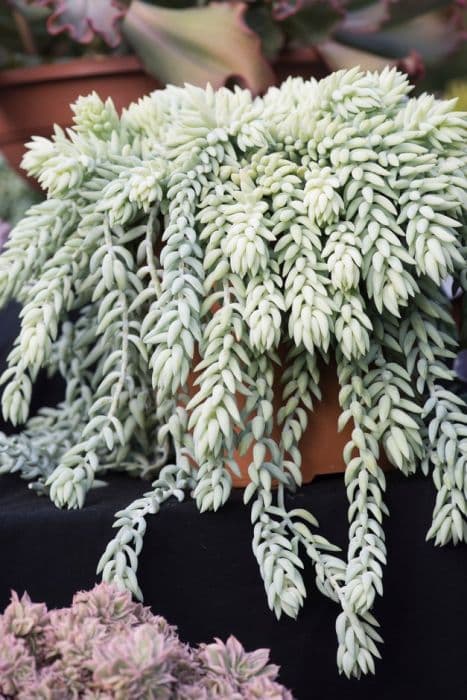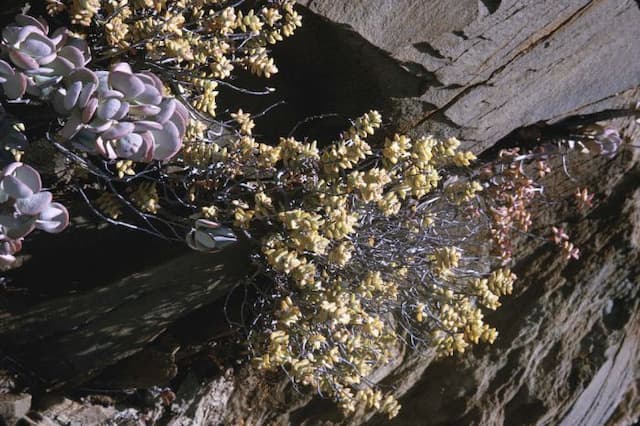Hen and chicks Sempervivum tectorum

ABOUT
The plant commonly known as hens and chicks is a perennial succulent that boasts a rosette structure, which gives it a distinctive and attractive appearance. Each rosette is formed by thick, fleshy leaves that are green in color, often with purplish or reddish tips. These leaves are arranged in a spiraling pattern, overlapping each other tightly to form the main structure of the rosette. The edges of the leaves may be slightly jagged or smooth and can sometimes show a fine hair-like fringe. During the flowering period, the hens and chicks plant sends up a central stalk from the main rosette, which bears star-shaped flowers. These flowers can range in color from pink to red, adding a lovely contrast to the green foliage. After flowering, the main rosette typically dies, but the plant's prolific reproduction through offsets ensures its continued growth. These offsets, or 'chicks,' cluster around the 'hen,' the main rosette, giving the plant its charming common name. The overall appearance of the hens and chicks is a dense cluster of succulent rosettes, creating a mat-like ground cover or an appealing feature in rock gardens or container arrangements.
About this plant
 Names
NamesFamily
Crassulaceae
Synonyms
Common Houseleek, Hen and Chicks, Roof Houseleek, Live Forever
Common names
Sempervivum alpinum Griseb. & Schenk, Sempervivum arachnoideum subsp. tomentosum (C.B.Lehm.) 't Hart, Sempervivum wulfenii Hoppe ex Mert. & W.D.J.Koch.
 Toxicity
ToxicityTo humans
Common Houseleek (Sempervivum tectorum) is generally not considered toxic to humans. There are no significant toxic effects reported from ingesting this plant, and it is even used in some traditional medicine practices. However, as with any plant material, individual allergies or sensitivities could potentially cause mild irritation or an adverse reaction.
To pets
Common Houseleek is also not known to be toxic to pets. It should not cause any significant symptoms of poisoning if ingested by animals such as cats and dogs. However, ingestion of any non-food plant material can potentially lead to gastrointestinal discomfort or distress in pets, such as vomiting or diarrhea, due to the plant’s fibrous nature. Always monitor your pet's health and consult a veterinarian if you have concerns about their well-being after ingesting this or any plant.
 Characteristics
CharacteristicsLife cycle
Perennials
Foliage type
Evergreen
Color of leaves
Green
Flower color
Pink
Height
6 inches (15 cm)
Spread
2 feet (60 cm)
Plant type
Succulent
Hardiness zones
3
Native area
Europe
Benefits
 General Benefits
General Benefits- Easy to grow: Sempervivum tectorum, commonly known as houseleek, is a hardy plant that requires minimal care and can thrive in a variety of conditions.
- Drought tolerant: Houseleek is extremely drought-resistant, making it an ideal plant for rock gardens or areas prone to water scarcity.
- Cold hardy: It can survive in cold temperatures and is suitable for growing in temperate climates.
- Decorative: With its rosette shape and variety of colors, houseleek adds aesthetic appeal to gardens, rockeries, and pots.
- Propagation: It propagates easily, producing offsets that can be separated and planted to create new plants.
- Low maintenance: Houseleek requires little maintenance, making it suitable for novice gardeners or those with busy lifestyles.
- Pest resistant: The plant is not typically subject to serious pest or disease problems.
- Roof planting: Historically used to plant on rooftops, it is believed to protect the home from lightning and fire.
- Ground cover: Houseleek can be used to provide a dense, low-growing ground cover that helps prevent soil erosion.
 Medical Properties
Medical Properties- Anti-inflammatory: Sempervivum tectorum, commonly known as Common houseleek, has been traditionally used to reduce inflammation.
- Antioxidant: It contains compounds that are believed to have antioxidant effects.
- Astringent: The juice or expressed sap of the leaves can have astringent properties, which might help in toning skin or minor wound healing.
- Diuretic: There is some historical use of the plant to promote urine production.
- Vulnerary: It has been used for its wound healing properties, particularly in the treatment and healing of minor cuts and skin irritations.
 Air-purifying Qualities
Air-purifying QualitiesThis plant is not specifically known for air purifying qualities.
 Other Uses
Other Uses- Sempervivum tectorum, commonly known as houseleek, has been traditionally used as a protective charm against lightning and fire when grown on the roofs of houses. Its succulent leaves are thought to provide a barrier against these elements.
- Houseleeks have been placed on thatched roofs to prevent rot and repel insects with overgrowth becoming intertwined with the thatch, potentially offering enhanced shelter and durability.
- The fibrous roots of houseleek have been used to make a weak natural dye for coloring wool and other natural fibers with a range of light green to brown hues.
- In rural architecture, especially in Europe, houseleek is incorporated into green roofs and living roof designs, contributing to insulation and creating aesthetic patterns.
- The succulent leaves of houseleek can be crushed and mixed with soil to improve water retention for other plants in the garden, as they break down slowly and release moisture.
- Gardeners use the drought-resistant nature of houseleek to create water-wise container gardens that require minimal maintenance and infrequent watering.
- Houseleeks are used in companion planting to deter pests like aphids, as their thick leaves are unappealing to many common garden pests.
- The aesthetic appeal of the houseleek's rosettes makes them a popular choice for living wreaths and table centerpieces, adding natural greenery to decorations.
- Artists and crafters sometimes incorporate houseleek plants into living sculptures and garden art, utilizing their varied colors and robust form.
- Houseleek's ability to thrive in shallow soil has made it a valuable plant for creating rock garden compositions and filling in crevices in stone walls.
Interesting Facts
 Feng Shui
Feng ShuiThe plant Houseleek is not used in Feng Shui practice.
 Zodiac Sign Compitability
Zodiac Sign CompitabilityThe plant Houseleek is not used in astrology practice.
 Plant Symbolism
Plant Symbolism- Longevity: Sempervivum tectorum, commonly known as Hens and Chicks, embodies longevity due to its ability to thrive in harsh conditions and its perennial nature.
- Protection: The plant's name means 'always living' in Latin, and it was traditionally used to protect roofs from lightning and fire, symbolizing a shield against adversity.
- Resilience: Hens and Chicks can survive with very little water and soil, demonstrating exceptional resilience and the ability to adapt to difficult environments.
- Maternal Care: The "hen" plant produces many "chick" offshoots, symbolizing motherly love and care through its reproduction method.
- Renewal: As older rosettes die, new ones take their place, thus Hens and Chicks are often associated with the continuous cycle of renewal and rebirth.
- Endurance: The plant's robust nature stands for endurance and the ability to withstand time and challenges.
 Water
WaterWater your Hen and Chicks (Sempervivum tectorum) sparsely and allow the soil to dry out between waterings. Typically, you should water these succulents once every 7 to 10 days during their growing season in the spring and summer, using about 8 to 10 ounces per plant. In the fall and winter, reduce watering to once a month or less, as the plant enters a dormant period. Always avoid waterlogging as this can lead to root rot, and ensure proper drainage in the pot.
 Light
LightHen and Chicks thrive best in full sunlight to partial shade. Ideally, place them in a spot where they can receive at least 6 hours of direct sunlight daily. They can tolerate high light conditions, so east or west-facing windowsills or a sunny spot outdoors are excellent choices for these hardy succulents.
 Temperature
TemperatureHen and Chicks prefer a temperature range between 65°F and 75°F for optimal growth but are extremely hardy and can tolerate temperatures as low as -20°F and as high as 90°F. Take care to protect your plants from extreme heat by providing some afternoon shade and in winter ensure they're not exposed to wet soil, as this can increase the risk of frost damage.
 Pruning
PruningPruning Hen and Chicks is generally done to remove dead or damaged leaves and to maintain plant appearance. Prune off dead rosettes or leaves as needed throughout the year with a clean, sharp tool. This also helps prevent rot and disease. The best time to prune is in the spring or early summer, but minimal pruning is usually required for this low-maintenance plant.
 Cleaning
CleaningAs needed
 Soil
SoilThe best soil mix for Hen and Chicks (Sempervivum tectorum) should be well-draining and gritty, resembling that of a succulent or cactus mix. One effective recipe includes a combination of potting soil, coarse sand, and perlite or pumice in equal parts. The ideal soil pH for Hen and Chicks is slightly acidic to neutral, ranging from around 6.0 to 7.5.
 Repotting
RepottingHen and Chicks (Sempervivum tectorum) should generally be repotted every 2 to 3 years to refresh the soil and provide room for growth. However, since they are slow-growing succulents, they can often be left undisturbed for longer periods unless they outgrow their container or the soil becomes compacted.
 Humidity & Misting
Humidity & MistingHen and Chicks (Sempervivum tectorum) are adaptable to a wide range of humidity conditions and prefer a drier atmosphere akin to their native alpine habitats. They thrive best in low humidity environments and do not require high humidity levels to flourish.
 Suitable locations
Suitable locationsIndoor
Place Hen and Chicks in bright light inside, away from dampness, for indoor growth.
Outdoor
Outdoors, Hen and Chicks need full sun and well-drained soil to thrive.
Hardiness zone
3-8 USDA
 Life cycle
Life cycleCommonly known as Hen and Chicks, Sempervivum tectorum begins its life as a seed that germinates in spring or early summer in well-draining, gravelly soil. The seedling develops into a rosette, the primary growth form, where it undergoes vegetative growth. During this stage, the plant produces offsets or "chicks" that cluster around the mother "hen." After a few years, usually between three to six, the mature rosette enters the reproductive phase, spontaneously producing a flowering stalk. The flowers are typically star-shaped, pink or red, and after pollination, they set seeds before the main rosette dies. The life cycle continues as the offsets develop into independent plants, repeating the process.
 Propogation
PropogationPropogation time
Spring-Early Summer
The common houseleek, Sempervivum tectorum, is propagated most effectively through the division of offsets. Typically, Spring to early Summer is the best time for propagation when the plant is actively growing. Offsets, which are small rosettes that form at the base of the parent plant, can be gently pulled away once they have a few roots of their own. These offsets can then be planted in well-draining soil and should be watered sparingly until they establish a stronger root system, usually within a few weeks. It is important not to overwater as the houseleek is a succulent and prone to rot in excessively moist conditions. This simple and efficient method of vegetative propagation helps expand your collection or share with others.









